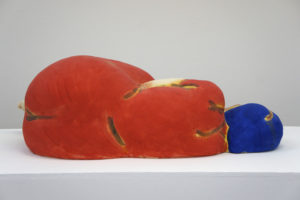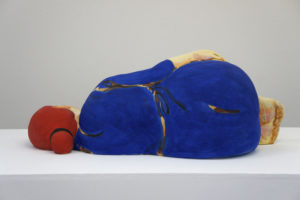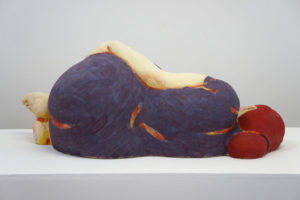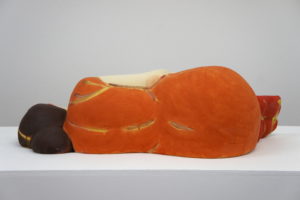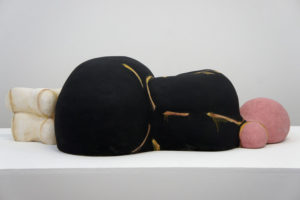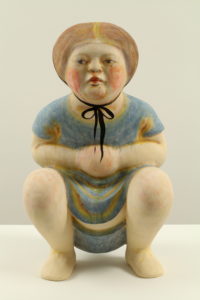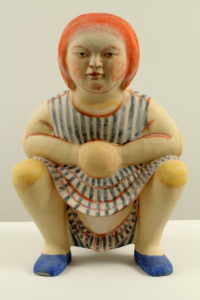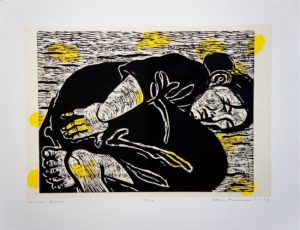February 21, 2013—March 30, 2013 | Reception Thursday, February 21st, 6 – 8pm
James Harris Gallery is pleased to announce Ground, an exhibition of new work by Akio Takamori. Marking the artist’s third solo exhibition at the gallery, featured works include large-scale ceramic sculptures and one woodblock print. A seminal figure working in the ceramic arts for more than twenty-five years, Takamori continues to explore themes of cultural identity by engaging the history of Eastern and Western aesthetics. Bold form and color defines this body of work, which is highly expressive of human emotion and sensuality.
Five stoneware “Sleeping Women” greet the viewer in the gallery’s main room, situated on an elongated pedestal with their backs to the audience. Creating the illusion of a mountainous landscape, the forms hearken to mannerist hyperbole, suggesting the curvy backside of iconic forms such as Ingres’ “La Grande Odalisque” (1814) or the exaggerated features of Mesopotamian stone sculpture. This arrangement of the Sleeping Women serves to emphasize their phenomenological presence and give the impression that the onlooker may be interrupting a private psychological moment. While their eyes remain open and far away in thought, the reposed sculptures’ expressions are nonetheless the laconic gazes of sleeping figures. With arms and legs pulled close to their bodies, they appear both physically and psychologically inward.
Awash in color, the Sleeping Women are characterized by their voluptuous forms, vivid hues and elegant painterliness. Takamori’s signature underglaze sensually stains their hair, cheeks and lips in bright red and electric blue. His painted sculptures are vibrant cultural landscapes that invoke the open brushstroke and expressionist colorations of Matisse, the flattened silhouettes and non-realist palette of the 20th century avant-garde, as well as a rich tradition of the ceramic arts. This intense coloration represents a shift in Takamori’s work.
The small gallery features yet another life sized sculpture, again facing towards the back wall. Donning a striped dressed, a small girl squats with her hands folded in front. The child-like figure appears to be absorbed in a solitary game with her bright orange hair in a low bun and a soft bow tied at the back of her dress. Takamori’s brushwork suggests the hard, low-relief repetitive lines found in classical sculpture of both Eastern and Western traditions with the folded drapery of her garment. Similar to the Sleeping Women, the girl’s expression remains stoic and thoughtful, yet she retains an air of playful sweetness, her underpants naively showing between her knees.
Akio Takamori
Takamori was a seminal figure in ceramic art, whose work over the past thirty years has left an enduring impact on the Pacific Northwest arts and the medium itself. His work is often autobiographical, drawing on his life in Japan, his family, and mythological themes. He is known for his coil-built figurative sculptures in which the narrative painting defines the form. Takamori explored themes of cultural identity by engaging the history of Eastern and Western aesthetics. Bold form and color defines his body of work, which is highly expressive of human emotion and sensuality.
Akio Takamori was born and raised in Japan. He has been exhibiting in the United States, Europe and Asia since the mid 1980s. Takamori received his BFA from the Kansas City Art Institute in 1976 and his MFA from the New York State College of Ceramics, Alfred University in 1978.
Takamori’s work is included in numerous collections including the Nelson-Atkins Museum of Art in Kansas City, Los Angels County Museum of Art, Victoria & Albert Museum in London, Ariana Museum in Geneva, the Seattle Art Museum, and the Museum of Arts and Design in New York City. He is the recipient of numerous awards, including three National Endowment for the Arts Visual Artists Fellowship Grants (1986, 1988, 1992), the Joan Mitchell Foundation Painters and Sculptors Grant (2006), and the USA Ford Fellowship (2011). Takamori was a professor of art at the University of Washington. He lived and worked in Seattle.
Stoneware with underglazes
10" x 31" x 17"
Private Collection, Portland, OR
Inquire about this work
Stoneware with underglazes
12" x 29" x 15"
Private Collection, Portland, Oregon
Inquire about this work
Stoneware with underglazes
12" x 30" x 16"
Private Collection
Inquire about this work
Stoneware with underglazes
10" x 32" x 15"
Private Collection
Inquire about this work
Stoneware with underglazes
11" x 36" x 18"
Private Collection, Boise, ID
Inquire about this work
Stoneware with underglazes
32" x 20" x 15"
Private Collection, Seattle, WA
Inquire about this work
Stoneware with underglazes
38" x 25" x 16"
Private Collection, Seattle, WA
Inquire about this work
Stoneware with underglazes
32" x 17" x 16"
Inquire about this work
woodcut, lithography, chine colle
17 1/2" x 22 1/2"
Edition of 28
Inquire about this work

